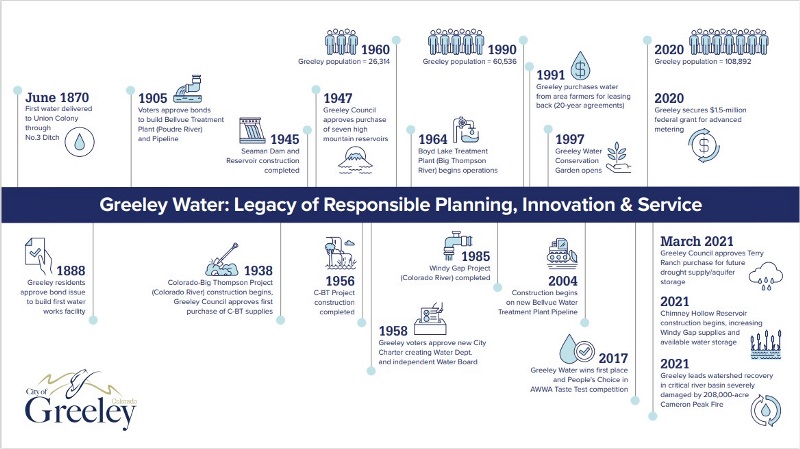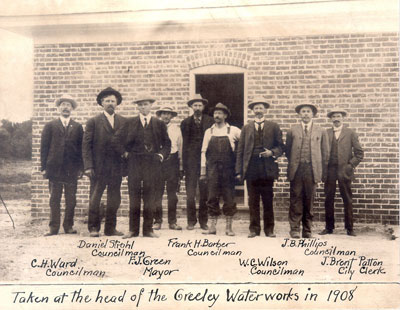Greeley's Water History
Pre 1830s
The confluence of the Cache la Poudre and South Platte Rivers was inhabited by nomadic Indian tribes, mainly the Arapahoe and Cheyenne. They utilized native plants and animals to survive and did not change the natural flow of the river.
1830-1850
During the 1830s, fur trappers arrived. By 1850, miners also settled here, living in crude cabins along the river.
1860
The Yeager was the first ditch built on the Poudre River. Located above Fort Collins it diverted water to irrigate hayfields along the river's flood plains.
1861-1866
With shovels and sweat, farmers etched irrigation ditches into the landscape. In 1861, the Watrous, Whedbee, Second, and Dry Ditches were dug. In 1866, the Boyd/Freeman Pioneer Ditch was built near Greeley, named after Robert Boyd.
1869
Nathan Meeker, agricultural editor of the New York Tribune visited Colorado and told Horace Greeley, editor of the Tribune, of his idea to start a colony there. The Tribune announced that a parcel of land in the new colony could be purchased for a $150 membership fee.
 1870
1870
The Number 3 Ditch began operation in June of 1870 and was the first completed ditch in the Greeley area. It is a 13-mile ditch that begins west of 71st Avenue and ends just south of the Weld County Airport at Fern Avenue.
1870-1872
B.H. Eaton ' s promise of assistance with the ditch construction hastened the arrival of Meeker and the Union Colonists. In 1872, the banks of Ditch No. 2, which was 35 miles long and irrigating 2,000 acres, failed to hold. At the time David Boyd said, “this loss of crops by the most enterprising and courageous of colonists- men of moderate means- came near to paralyzing the whole enterprise.” After this experience, they immediately realized the necessity of competent water engineers. Over the next few years, the canal would be enlarged three times and the river dammed, at a total cost of $87,000.
1874
Colonist farmers defended their rights to water. When those upstream broke their promises and used more than their share, threats of violence arose. Luckily, heavy rainfall cooled tempers.
1876
The State adopted the Doctrine of Prior Appropriation as part of the constitution. The prior appropriation system is based on the principle, “first in time, first in right.”
1878
The legislator divided the State into water districts and selected water commissioners for each one. David Boyd became the first commissioner to represent Greeley.
1879
Eaton Ditch was completed. David Boyd, who had criticized early engineers, said that now the “true way” of canal building had been learned.
1886
The early settlers of Greeley constructed their first water system, a series of infiltration wells in the City. The well water quality diminished as nutrients from surrounding farms flowed into the wells. The water continued to degrade until 1900 when the citizens decided to look for a new source.
1890
The first trans-mountain diversions, SkyLine, Michigan, and Grand River Ditches were constructed to bring water to the Poudre Basin from the western slope.
1895
By the 1890s, so many canals and ditches drained water from the rivers that little was left. Reservoirs were needed to store the water and allow the towns and irrigators to have a more reliable supply. Some of the largest reservoirs in the state were built in northern Colorado.
1904
Greeley bought a farm at the Poudre River's mouth in Bellvue, 35 miles northwest of town. The farm contained a very senior water right. Greeley combined this right with another senior water right and established a water supply that would satisfy the City for the next 40 years. The two rights still form the base of Greeley 's water system.

1905
Boyd Lake was first used for water storage.
1907
Greeley finished construction of its Bellvue Treatment Facility, consisting of 2.5 acres of slow sand filters. The original municipal gravity water system was completed in 1907. Thirty-six miles of 20-inch diameter wooden pipeline stretched past irrigated lands near the foothills to bring Poudre River water to the City of Greeley. Until this time, Greeley residents relied on infiltration wells built into the gravel bed of the river, a short distance from the center of town, to provide water to their homes.
1921
The Barnes Meadow Reservoir was built, providing 5.5 million gallons of storage.
1927-1933
The collapse of agricultural markets accompanied a severe drought. By 1933, erosion was visible and billowing clouds of airborne topsoil became part of the “Dust Bowl” that stretched from the Dakotas to Texas. The Great Depression was nationwide and northern Colorado farmers were some of the hardest hit.
1937 -1957
 After being denied water from the North Platte River in a 1933 Supreme Court decision, residents looked to the “Last Water Hole in the West”, the Colorado River, to alleviate their thirst. They needed water and they needed jobs. In 1937, President Roosevelt appropriated $900,000 to begin the construction on an immense public works undertaking, the Colorado-Big Thompson Project, originally the Grand Lake Project, that would take 19 years to complete. It would deliver 13.4 million gallons of water per day to Eastern Slope communities. The project financed the construction of the 13.1 mile-long Alva B. Adams Tunnel, 10 reservoirs, 13 dams, six power plants, three pumping plants, and numerous canals and waterways. The final cost of the internationally acclaimed project would be $164 million. The Northern Colorado Water Conservancy District was organized to oversee the project.
After being denied water from the North Platte River in a 1933 Supreme Court decision, residents looked to the “Last Water Hole in the West”, the Colorado River, to alleviate their thirst. They needed water and they needed jobs. In 1937, President Roosevelt appropriated $900,000 to begin the construction on an immense public works undertaking, the Colorado-Big Thompson Project, originally the Grand Lake Project, that would take 19 years to complete. It would deliver 13.4 million gallons of water per day to Eastern Slope communities. The project financed the construction of the 13.1 mile-long Alva B. Adams Tunnel, 10 reservoirs, 13 dams, six power plants, three pumping plants, and numerous canals and waterways. The final cost of the internationally acclaimed project would be $164 million. The Northern Colorado Water Conservancy District was organized to oversee the project.
1940-1945
The City of Greeley built the Seaman Dam and Reservoir. In 1945, Greeley finished construction of Milton Seaman Reservoir on the north fork of the Poudre River upstream from the Bellvue Treatment Plant. The reservoir captured spring runoff and released it later in the summer when demand exceeded the two senior direct flow rights.
1944
Crews working from east and west holed through the Continental Divide Tunnel, now known as the Alva B. Adams Tunnel. NBC Radio broadcasted the event live nationally.
1947
The City of Greeley purchased high mountain reservoirs consisting of 11 water supply structures in the Poudre Basin, providing 561,000 gallons of water. Also this year, the first water passed through the Adams Tunnel. It takes water 2 ½ to 3 hours to travel to the Eastern Slope.
1952
Greeley adds additional transmission lines from the Bellvue Treatment Plant to Greeley.
1961
Greeley began accepting shares of the Greeley-Loveland Irrigation System, comprised of three interrelated companies: Greeley Loveland Irrigation Company ( Boyd Lake ), Loveland and Greeley Reservoir Company ( Lake Loveland ), and Seven Lakes Reservoir Company (Horseshoe Reservoir).
1969
Greeley completed the construction of Boyd Lake Water Treatment Plant, allowing the City to use Big Thompson River water diverted by the Greeley-Loveland Irrigation Company.
1969 -1987
Greeley and six other Front Range municipalities jointly developed the Windy Gap Project. This project is a trans basin diversion project that delivers water from the Colorado River to the East Slope, using the C-BT system. Windy Gap supplies are wholly consumable, allowing Greeley to reuse Windy Gap water more than once.
1972
Congress passed the Clean Water Act in an effort to clean the nation's waterways.
1976
Greeley and Northern Colorado experienced a pair of disasters: first drought, then a flash flood on the Big Thompson River that killed 145 people.
1991
Greeley obtained 3.2 billion gallons of water supplies and supported local agriculture by buying water from local farmers, then renting it back to them for 20 years. 1995 The Greeley Water and Sewer Board adopted a water conservation implementation plan in order to address Greeley ' s growing water needs as the population exceeded 60,000.
1999
Greeley started to develop a Master Plan for the next 20-50 years.
2000-2003
Greeley was the nation's fastest-growing metro area between April 1, 2000 and July 1, 2003 according to "Population Change in Metropolitan and Micropolitan Statistical Areas: 1990-2003," a report by the U. S. Census Bureau. The Census Bureau reported growth in the Greeley metro area at 16.8 percent between 2000 and 2003. The population of Greeley was 84,519 in 2003.
2002
The drought of 2000-2004 was more severe than anyone expected. According to tree ring studies, 2002 was the worst single year in the last 300 years. This year also recorded extremely low statewide snowpack and stream flows. This effect was intensified by low annual precipitation (12-14 inches average vs. 8.4 inches in 2002) and very high temperatures. The third hottest July in history was in 2002. It was the first time in 50 years that Greeley had to draw from storage.
2003
The City of Greeley Water Master Plan was completed. The Water Master Plan defines specific steps to provide a reliable water supply for Greeley to the year 2020.
2004
Construction began on a new 60-inch transmission pipeline that transports drinking water from the Bellvue Water Treatment Plant northwest of Fort Collins to the Gold Hill Reservior and water tower in west Greeley. The pipeline will add capacity to Greeley's existing lines in the area, originally built between 1907 and 1952.
2006
The City purchased shares in the Windsor Reservoir and Canal Company giving the City the rights to a portion of the water diverted from the Laramie River by the Tunnel Water Company.
2007
The City of Greeley celebrated the 100 year anniversary of the treated water system. Events and tours helped mark the milestone.
2009
Greeley's Water Conservation Plan was approved by the Colorado Water Conservation Board. Greeley’s conservation plan predicts a more than eight percent reduction in Greeley's water demand over the next 20 years.
2014 -2017
Greeley developed a water budget rate structure program. It took time to develop the most accurate and equitable way of addressing community water needs.
 2015
2015
Greeley's population continues to rise at a rapid rate. In 2015, the city reached a milestone of 100,000 residents.
2017
At the American Water Works Association’s 13th annual “Best of the Best” Water Taste Test held in Philadelphia, a sample of Greeley’s tap water was not only named the best-tasting in all of North America. Greeley's tap water also won the People’s Choice award. It was the first time a city claimed both titles in a single year.
2019
The transmission pipeline project that began in 2003 is closer to completion. Approximately, 25 of the 29 miles of pipeline is completed and in service. Staff is currently working on the last segment of the project. This includes easement acquisition and final design. Construction is planned to begin in 2020.
2021
On March 2, 2021, the Greeley City Council unanimously approved an ordinance that made it possible for the city to purchase 1.2 million acre-feet of groundwater called Terry Ranch, an underground, non-tributary aquifer. This purchase will help secure the city’s future water needs to support 260,000 population expected in 2065. The council also allowed the city to issue water credits for use of the Terry Ranch water to developers who planned to build in Greeley. With the approval, the city was able to drop its plans to enlarge Milton Seaman reservoir, which had been languishing for several years with little hope in sight for approval.